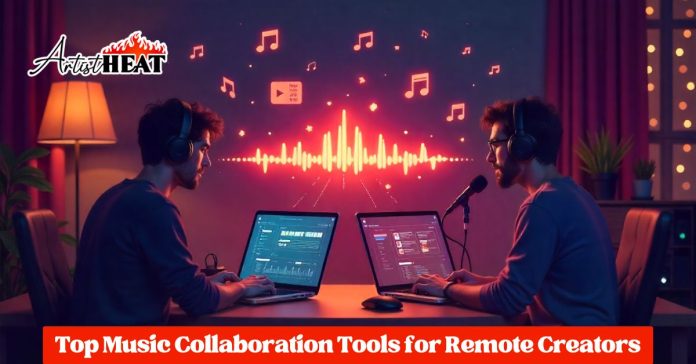The recording business has completely evolved in the last couple of years and quite frankly, it was high time. Nights of sitting in the same studio breathing the same outdated air and coming up with something magical together are long gone. Today’s music collaboration tools for remote creators have revolutionized how artists work together, breaking down geographical barriers and opening up possibilities that would have seemed impossible just a decade ago.
As we all know, the old model of the music industry was rather gatekeeperish. You had to be connected, pay hundreds of dollars an hour to be in a studio and usually sell out your artistic ideas to accommodate another person. Yet the year 2025 has introduced us to a new set of times whereby a producer in Tokyo can effectively work with a singer in Nashville and a guitarist in London without leaving their respective bedrooms. And believe me some of the best music is going on in bedrooms now-a-days.
The Reality Check: Why Remote Collaboration Actually Works
Before we go into the tools that are transforming the game, we should mention the elephant in the room. A few tradition musicians still argue that remote collaboration is not as magic as being in the same room. Although there is some truth behind common energy and unexpected moments, this attitude is getting more and more outdated.
The truth is, top music collaboration tools for remote creators have evolved to capture nuances that were previously lost in translation. What modern platforms allow is real-time collaboration with a minimum amount of latency, quality audio streaming and sometimes even features which positively affect the creative process instead of being hindering.
Such performers as Billie Eilish and FINNEAS demonstrated in the first place that bedroom production could be as good as a studio that costs millions of dollars. These days, there are cross-overs with people who have never even met in person giving out hits that lead to the popular charts. It has taken the technology long enough to keep up with our dreams.
BandLab: The Social Network That Actually Delivers
Let’s start with BandLab, which has become something of a phenomenon in the music collaboration tools for remote creators space. The uniqueness of BandLab, however, does not lie in its free cost, although it is also definitely an advantage to this platform, but rather in its integration of social networking with the actual serious production.
Using BandLab, several users may collaborate on the same project: each participant can add his own tracks, effects, and edits to the project in real time. It supports the entire MIDI sequencing as well as audio recording and the cloud storage nature implies you can work on your projects anywhere. Other musicians such as Grimes have extolled sites such as this as democratizing the art of music creation and she is not mistaken.
The area that BandLab performs excellently is the social side. You have a chance to find partners according to their capabilities, previous projects, or musical genre. It is MySpace that should have been LinkedIn, but is, in fact, useful and much less pretentious.
Splice Sounds: When Collaboration Meets Curation
Splice has evolved far beyond its original sample library roots to become one of the most important top music collaboration tools for remote creators available today. The Splice Sounds offered on the platform enables producers to get millions of royalty-free sounds and loops, and one-shots, but the collaborative features make the platform extraordinary.
What should make Splice so beautiful is also the fact that the creators can decide to add to what others make with no legal nightmares. Once one of the producers uploads a project to Splice, the other collaborators are permitted to download individual stems and add even their own elements and re-upload with fresh versions. It is as real-time musical evolution.
Splice has been used heavily by artists like Lil Nas X in the production process, and the company has had a hand in too many viral hits to count. The equalizing of the high-quality sounds has occurred in the way bedroom producers gain access to the same sound palette that acts and labels have access to.
Soundtrap: Google’s Gift to Collaborative Music
Google’s Soundtrap deserves serious recognition in the music collaboration tools for remote creators conversation. Since Soundtrap is a web-based DAW, there is no need of costly software, or high-powered hardware. And it only requires Internet connection to be able to collaborate.
The peculiar feature of Soundtrap lies in the fact it is closely integrated with the ecosystem of Google. It is possible to send projects through the Google Drive, collaborate in real-time similarly to on a Google Doc, and even utilize Google Meet to have a video chat when you work on tracks together. The platform allows several users to work on it at the same time and changes occur in real-time.
Educational institutions have used the tool the most as it has become very popular in learning institutions but also professional artists are appreciating its potential uses. The fact that a browser can run it completely eliminates the need to cross software and version compatibility issues among the collaborators.
Sessionwire: Professional-Grade Remote Recording
For artists who demand professional-quality remote recording, Sessionwire represents the cutting edge of top music collaboration tools for remote creators. It is a remote specifically built to reproduce recording sessions, with near real-time latency audio streaming and professional recording inside of its capabilities.
Using sessionwire, musicians can play real time on the internet, with each musician recording the audio signal through their machine with maximum quality. The platform then synchronizes it all together, making a professional multitrack recording in which everybody sounds like he/she were in the same room.
Sessionwire has now come to replace traditional jam room sessions with major artists and producers using it to do song writing sessions and even complete recording of albums. The platform, especially in our global events that inhibit traveling, has also been highly useful, and indeed distance and quality do not have to be mutually exclusive.
The Future of Musical Collaboration
Looking ahead, the music collaboration tools for remote creators landscape is evolving rapidly. Artificial intelligence is slowly starting to find its way in, with AI powered tools assisting in finding friends that have similar working styles and even trying to recommend music pieces that can accompany others in this track.
There is also the virtual and augmented reality. Consider working in a virtual studio environment in which you are able to visualise and communicate with your associates in the similar room even with spatial audio and haptic feedback. Such technologies are already being developed by companies, and they can shake the very perception of remote cooperation.
Blockchain-based technology is also stirring in the air, with experiments on how to apply distributed ledgers to automatically manage collaborative works royalties and credits. This can bring about some of the largest headaches of music collaboration which is to ensure that all individuals are getting their fair share with credits being given to them accordingly.
Making It Work: Practical Tips for Remote Collaboration
The tools are only as good as how you use them. Successful remote collaboration requires clear communication, defined roles, and realistic expectations about timing and creative input. The best music collaboration tools for remote creators in the world won’t help if collaborators aren’t on the same page about the project’s direction.
It is important to establish a healthy project management. Utilize common calendars and file names, develop communication guidelines and get into the creative work. Research has shown, the most effective remote teamwork can include the figure of a project manager who can bring everyone to order and keep their activities under control.
Technical preparation is not less important. Involve collaborators who can enjoy reliable internet connection, compatible audio interfaces, and who have the knowledge of the platform, which is to be utilized. An initial five minutes technical guide will save hours of frustration in the future.
The landscape of top music collaboration tools for remote creators continues to expand and evolve, offering unprecedented opportunities for musical creativity. According to these tools, any bedroom producer who wishes to work with vocalists across the globe, find innovative partners to work on their creative ideas have made it easier than before and this is possible without geographical locations.
The future of music is cooperative, connected and closer than ever. The question is only:: what shall I make next?

